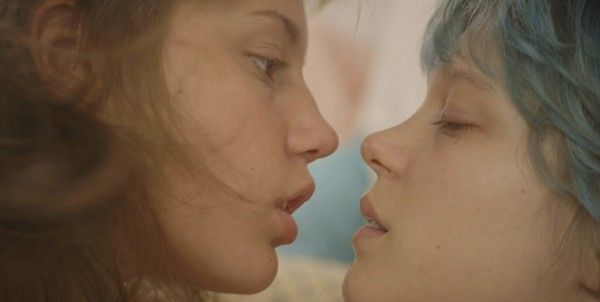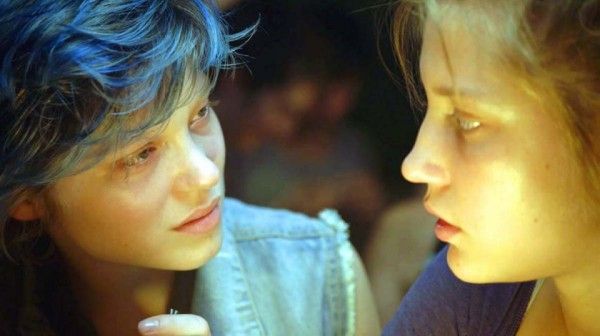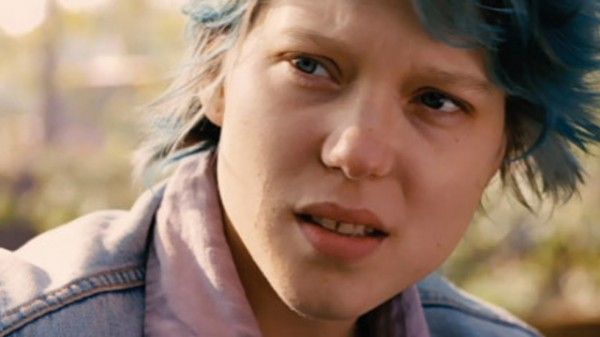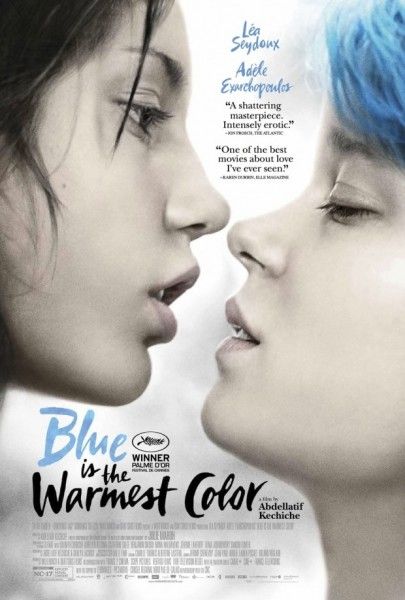Blue Is the Warmest Color Sex Scene Time
[This is a re-post of my review from the 2013 Toronto International Film Festival. Blue Is the Warmest Color opens today in limited release.]
I have to give credit where credit is due, and my colleague Adam Chitwood perfectly described Blue Is the Warmest Color when he said after the screening, "It's epically intimate." At three hours, director Abdellatif Kechiche's romantic drama lets us soak in every scene as we become intimate with its protagonist's desire for intimacy. The film can at times be heavy but it can also weave in subtlety through small visual cues. But even when the scenes run on too long, and we begin to float adrift, Adèle Exarchopoulos' heartbreaking performance keeps us anchored in a tale of ephemeral love.
The story spans years, and begins with a teenaged Adele (Exarchopoulos) beginning to discover her sexuality. On her way to have a date with a handsome classmate, she passes by a young woman with striking blue hair. After some sexual discovery with a couple of classmates, Adele goes searching for her crush, and finds the blue-haired woman, Emma (Lea Seydoux), in a lesbian bar. The two start to fall for each other and eventually become lovers and partners. But as the two grow older, Adele's adolescence never seems to fade and her desire becomes dependency as she feels her relationship faltering.

Kechiche's pacing is strikingly deliberate. After the brief glance at Emma early in the movie and Adele having an intense sexual dream about her, we don't see the blue-haired siren for almost forty minutes. The director takes all of that time teasing us. We know Emma will come back, but there's no meet-cute here. Adele has to grow into the search, first with unsatisfying sexual intercourse, and then a brief kiss with a female friend that doesn't grow into anything more. When Emma and Adele finally do meet up, Kechiche takes more time to develop their relationship, find their common interests, see how Emma brings Adele out of her shell, and then, 80 minutes into the movie, the sexual fireworks Adele has been seeking explode.
Like every scene in the movie, Kechiche goes long. If a moment is important to Adele, it should be important to us, and for the director, lengthiness conveys importance. So to his credit, it's tough to call the sex scene between Adele and Emma "gratuitous" because it receives just as much time as other scenes. But sex is different, and in the case of Blue Is the Warmest Color, incredibly graphic. Kechiche briefly steps over the line of exploitative, but for the most part, he's earned the scene because everything Adele has done has been leading to this climax.

It's also the movie's turning point where Adele now has everything she wants. She's found love and fantastic sex. What more could a young girl ask for? She could ask to grow alongside her partner. Exarchopoulos' casting is perfect not just because of her performance, but because she doesn't appear to physically age. Other characters comment on her youthful look, and it represents her arrested development. She can't comprehend a future where she and Emma aren't at the center of each other's worlds. Other parts of life can be in their orbit, but Adele needs Emma because Adele is alone. She has friends, but they're jerks. When she's with her family, they eat in silence. Emma is her salvation.
"Salvation" is a loaded word, but Kechiche isn't afraid to go big if he has to, and most of the time, the approach is appropriate. When Emma and Adele kiss early in their relationship, a golden sunset shines in between their faces. The camera lingers on their full, sensual lips. The movie has no non-diegetic music, but the sound effects let us clearly hear every smack of a kiss. We're wrapped up in Adele's love, but we're also the ones paying attention in class where teachers indirectly give dire warnings by talking about the subject matter of the literature the class is studying. There are times when the story screeches to a halt to explain literary themes or the girls start talking about Sartre and existentialism in order to provide foreshadowing. To be fair, Kechiche also provides some nice little touches like moving the hair out of Adele's face when she completely falls for Emma and making Emma's hair completely blue when she falls for Adele (Adele's hairstyle is almost a supporting character).

But on the occasions when Kechiche does stray or becomes too obvious or devotes too much time to one scene, he always has a saving grace in Exarchopoulos. Adele is in every scene, and it's her behavior that drives every scene forward. The character goes through a range of emotions, but she always has our sympathy because she's so innocent. There's something very pure and very sad in her behavior because she desperately wants love, but that need has defined her. A positive search turns into a burden. It's not even a matter of obsession. Adele's relationship with Emma is both common and unique, and it's Exarchopoulos that gives it that uniqueness. Her big doe eyes are enchanting, but always searching—searching for love, and searching for threats to that love because without it, she's lost. Kechiche and Exarchopoulos let us live in that love and loss.
In Adele's classes, teachers impart life lessons through books, but they're only reading French literature. Perhaps if they had read the Odyssey, Adele may have learned an important lesson the poem imparts when Odysseus and Penelope finally reunite: people change. The challenge of love isn't just to find its beginning, but its continuation free from paranoia and self-doubt. Blue Is the Warmest Color lets us walk alongside a static character who isn't boring; she's tragic.
Rating: B+

Source: https://collider.com/blue-is-warmest-color-review/
0 Response to "Blue Is the Warmest Color Sex Scene Time"
Post a Comment